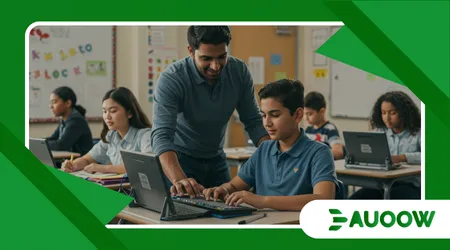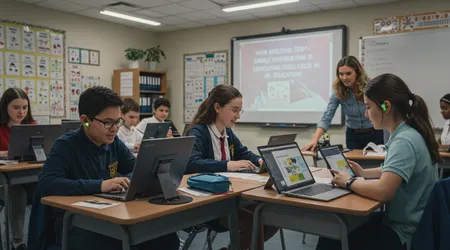How Assistive Tech Is Leveling the Playing Field in Education

Assistive tech is leveling the playing field in education, breaking barriers for students with disabilities.
Imagine a classroom where every learner, regardless of physical, sensory, or cognitive challenges, thrives with equal opportunity.
In 2025, this vision is becoming reality as innovative tools transform inclusive education.
From screen readers to AI-driven platforms, these technologies empower students, fostering independence and equity.
This article explores how assistive tech is leveling the playing field, diving into its mechanisms, impact, and real-world applications, with a focus on creating accessible, inclusive learning environments.
The journey toward inclusive education has been long, marked by policy shifts like the 1994 Salamanca Statement, which championed access to mainstream schools for students with special needs.
Today, assistive tech is leveling the playing field by addressing diverse learning needs with precision.
According to a 2023 UNESCO report, 2.5 billion people globally require assistive products, underscoring the demand for equitable solutions.
These tools don’t just aid students; they redefine how education systems operate, ensuring no one is left behind. Why should any child be excluded from learning when technology can bridge the gap?
The Evolution of Assistive Technology in Education
Assistive technology (AT) has evolved from basic tools like magnifying glasses to sophisticated AI-driven systems.
Screen readers like JAWS and NVDA now offer customizable interfaces, enabling visually impaired students to navigate digital content seamlessly.
Voice recognition software, such as Dragon NaturallySpeaking, empowers those with motor impairments to engage effortlessly.
These advancements ensure assistive tech is leveling the playing field by making education accessible across diverse needs, fostering autonomy in learning environments.
The integration of AI has further revolutionized AT, introducing tools like real-time captioning for deaf students and text-to-speech for dyslexic learners.
Platforms like Google’s WaveNet provide natural-sounding speech, enhancing user experience.
In 2025, schools leverage these tools to create inclusive curricula, ensuring students with disabilities engage fully.
++ The Role of Teacher Training in Successful Inclusive Education
By reducing reliance on traditional teaching methods, assistive tech is leveling the playing field, allowing personalized learning that caters to individual strengths and challenges.
Beyond hardware, accessible technologies mainstream devices with built-in AT features reduce stigma. Smartphones with voice-to-text capabilities, for instance, allow students with dyslexia to participate without specialized devices.
This shift promotes inclusion by normalizing assistive tools in classrooms.
As AT becomes more integrated, assistive tech is leveling the playing field, ensuring students focus on learning, not their limitations, creating a seamless educational experience.

Breaking Down Barriers with Assistive Tech
For students with visual impairments, tools like braille displays and screen magnifiers open doors to digital content.
A 2024 study by the American Foundation for the Blind found 78% of visually impaired adults use text-to-speech daily, highlighting its impact.
These tools enable students to access textbooks and websites independently, ensuring assistive tech is leveling the playing field by removing traditional barriers to literacy and information.
Hearing-impaired students benefit from real-time captioning and assistive listening systems.
For example, a deaf student in a New York high school uses an AI-powered transcription tool to follow lectures live.
Also read: How to Create IEPs That Actually Empower Students
Such innovations ensure full participation in discussions, fostering social inclusion. By addressing auditory challenges, assistive tech is leveling the playing field, creating equitable access to classroom interactions and collaborative learning.
Students with motor disabilities rely on adaptive keyboards and eye-tracking systems to navigate digital platforms.
Consider Maria, a 15-year-old with cerebral palsy, who uses eye-gaze technology to complete assignments.
These tools empower her to express ideas without physical constraints, proving that assistive tech is leveling the playing field by enabling active participation in academic tasks and boosting confidence.
Cognitive and learning disabilities, like dyslexia or ADHD, are also addressed through AT.
Apps like Spell Better help dyslexic students improve literacy, while time-management tools assist those with ADHD in organizing tasks.
These solutions tailor education to individual needs, ensuring assistive tech is leveling the playing field by fostering academic success and reducing frustration in learning processes.
Read more: How Universal Design for Learning Is Redefining Inclusive Classrooms
Real-World Impact: Stories of Transformation
Consider Jamal, a 12-year-old with autism in a Chicago middle school. His teachers implemented a service-learning project using a tablet-based communication app, enabling him to interact with peers and build confidence.
This example shows how assistive tech is leveling the playing field, turning social challenges into opportunities for growth and inclusion in collaborative settings.
In rural India, a visually impaired student named Priya uses a smartphone with built-in screen-reading software to access e-books.
Her school’s adoption of accessible technology has allowed her to excel in literature, previously inaccessible due to limited braille resources.
This underscores how assistive tech is leveling the playing field, bridging gaps in resource-scarce environments and empowering underserved students.
Globally, assistive tech impacts millions. A 2023 Yale Center for Dyslexia study revealed that audio-assisted learning boosts retention by 30% for dyslexic students.
Such data highlights the transformative power of AT in academic settings, ensuring assistive tech is leveling the playing field by enhancing comprehension and engagement for diverse learners.
In a South African classroom, a teacher uses virtual manipulatives to teach math to students with cognitive disabilities.
These interactive tools simplify complex concepts, enabling hands-on learning.
By adapting content to individual needs, assistive tech is leveling the playing field, making abstract subjects accessible and fostering a sense of achievement.
Policy and Implementation: Scaling Inclusion
Governments and schools are prioritizing AT integration, driven by policies like the European Accessibility Act of 2025, mandating accessible digital platforms.
Schools now allocate budgets for AT training, ensuring teachers use tools effectively.
This systemic shift ensures assistive tech is leveling the playing field by embedding inclusion into educational frameworks and practices.
Teacher training remains critical. Without proper guidance, AT can be underutilized, as seen during the COVID-19 shift to online learning, where inaccessible platforms excluded many.
Professional development programs now focus on AT proficiency, ensuring assistive tech is leveling the playing field by equipping educators to support diverse learners effectively.
Cost and availability pose challenges, particularly in low-income regions. Open-source solutions like NVDA and government subsidies are addressing this, making AT more accessible.
By reducing financial barriers, assistive tech is leveling the playing field, ensuring equitable access to education across socioeconomic divides.
Partnerships with tech companies are scaling AT adoption. For example, Microsoft’s collaboration with schools provides free accessibility tools, like Immersive Reader, to millions.
These initiatives ensure assistive tech is leveling the playing field by integrating inclusive solutions into mainstream education systems, fostering long-term equity.
The Future of Assistive Tech in Education

Looking ahead, AI-driven personalization will redefine AT. Imagine a virtual assistant tailoring lessons to a student’s pace, like a guide navigating a mountain trail, adjusting for each climber’s needs.
This adaptability ensures assistive tech is leveling the playing field by creating dynamic, student-centered learning experiences in 2025 and beyond.
Emerging technologies like virtual reality (VR) offer immersive learning for students with sensory impairments.
VR simulations allow visually impaired students to “experience” historical events, enhancing engagement.
By pushing boundaries, assistive tech is leveling the playing field, making education vivid and accessible for all learners.
Ethical considerations, like data privacy, are critical as AT collects user data. Compliance with GDPR and WCAG 2.2 ensures trust, protecting students’ rights.
By prioritizing ethics, assistive tech is leveling the playing field, balancing innovation with responsibility in inclusive education.
The assistive tech market is projected to reach $40 billion by 2025, per Grand View Research, reflecting growing demand.
This growth fuels innovation, ensuring assistive tech is leveling the playing field by expanding access to cutting-edge tools that empower students globally.
Table: Examples of Assistive Technology in Education
| Disability Type | Assistive Technology | Function |
|---|---|---|
| Visual Impairment | Screen Readers (e.g., NVDA) | Converts text to speech or braille |
| Hearing Impairment | Real-Time Captioning | Transcribes lectures for accessibility |
| Motor Disability | Eye-Tracking Systems | Enables navigation without physical input |
| Cognitive Disability | Text-to-Speech Apps (e.g., Spell Better) | Supports reading and comprehension |
Conclusion: A More Inclusive Tomorrow
Assistive technology is not just a tool; it’s a movement toward equity, ensuring every student has a voice in the classroom.
In 2025, assistive tech is leveling the playing field by dismantling barriers and fostering independence. From Jamal’s communication app to Priya’s e-books, these tools create opportunities where none existed before.
As policies evolve and innovations emerge, the future of education is inclusive, vibrant, and accessible. Isn’t it time we ensure every learner can shine?
The impact of AT extends beyond academics, fostering empathy and collaboration among students.
By normalizing diverse learning needs, assistive tech is leveling the playing field, building a culture of inclusion that benefits society. Let’s continue investing in these tools, ensuring education is a right, not a privilege, for all.
Frequently Asked Questions
What is assistive technology in education?
Assistive technology includes devices and software, like screen readers and voice recognition, designed to support students with disabilities in accessing education equitably.
How does assistive tech benefit students without disabilities?
Accessible technologies, like smartphones with built-in features, enhance learning flexibility and reduce stigma, benefiting all students by normalizing inclusive tools.
Are there affordable assistive tech options for schools?
Yes, open-source tools like NVDA and subsidized programs from companies like Microsoft make assistive tech accessible, even in low-resource settings.
How can teachers integrate assistive tech effectively?
Teachers need training to use AT tools like captioning or adaptive keyboards, ensuring they align with students’ needs and curriculum goals.
